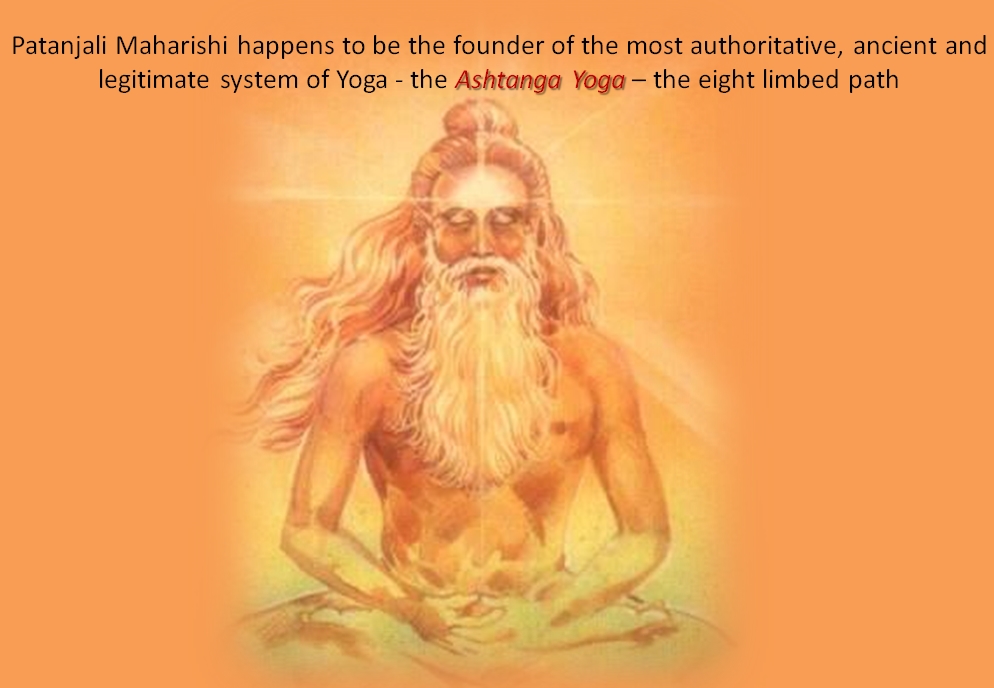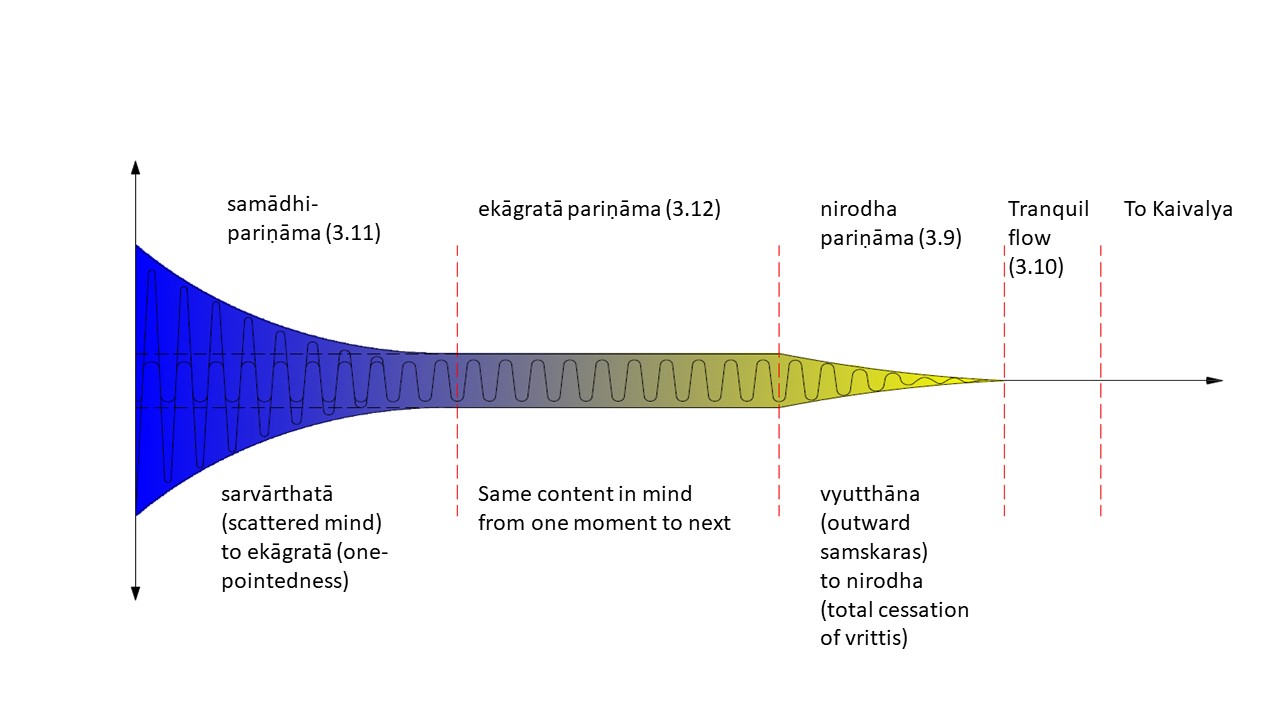Sutra 3.9
व्युत्थाननिरोधसंस्कारयोरभिभवप्रादुर्भावौ निरोधक्षणचित्तान्वयो निरोधपरिणामः॥९॥
Vyutthāna=outgoing impressions; nirodha=suppressive; saṁskārayoḥ=of the samskaras; abhibhava=overpowering, disappearance; prādurbhāvau=appearance; nirodha=suppression; kṣaṇa=moment; citta=mind; anvayaḥ=proceeding; nirodha=suppression; pariṇāmaḥ=transformation
Sw. Satchidananda
"The impressions which normally arise are made to disappear by the appearance of suppressive efforts, which in turn create mental modifications. The moment of conjunction of mind and new modification is nirodha parinama."
Bryant
"The state of restraint, nirodha, is when there is disappearance of outgoing [i.e. worldly] samskaras and the appearance of restraining samskaras. These emerge in the mind at the moment of restraint."
Taimni
"Nirodha Parinama is that transformation of the mind in which it becomes progressively permeated by that condition of Nirodha which intervenes momentarily between an impression which is disappearing and the impression which is taking place."
First thing to note here is that we are talking of only samskaras, not the seed of an object of meditation. That implies that we are in the state of asamprajnata samadhi wherein we have gone past the samprajnata samadhi by eliminating the object of meditation. As per sutra 1.18, at this point only the samskaras have remained in the chitta.
Here we are talking of two kinds of samskaras. Vyutthana refers to the state when a thought arises in the mind based on a previous samskara. So, for example, while in the state of deep meditation, I suddenly think of eating a mango, that will be termed "vyutthana". When I am able to suppress the thought and go back into deep meditation, I am able to create a new "nirodha samskara" or the samskara of thoughtlessness. This transition into the state of "no thought" from the one where there is a vyutthana (or uprising of) samskara has been defined as "nirodha parinama" (transformation of suppression) in this sutra.
Vyasa, in his commentary states that vyutthana samskaras are the nature (dharma) of the mind, not necessarily a result of vrittis. Even when the vrittis have been subdued, the vyutthana samskaras can still appear in the mind. This happens because of the constant play of the three gunas – sattva, rajas and tamas. Because the gunas are always in a state of flux, even in the absence of vrittis the samskaras will continue to rise and fall. It is only when we reach the state of "kaivalya", the vyutthana samskaras will be fully subdued and only nirodha samskaras will remain.
Sutra 3.10
तस्य प्रशान्तवाहिता संस्कारात्॥१०॥
Tasya=its (nirodha pariṇāma of previous sutra); praśānta=undisturbed; vāhitā=flow; saṁskārāt=from subliminal impressions
Sw. Satchidananda
"The flow of nirodha parinama becomes steady through habit."
Bryant
"The mind’s undisturbed flow occurs due to samsakaras."
Taimni
"Its flow becomes tranquil by repeated impression."
This sutra just states what happens to the mind when the "nirodha samaskaras" mentioned in the previous sutra begin to dominate the mind. In that case, the mind flows in a very peaceful state. Vyasa says that to get to this state one needs to maintain a constant practice (abhyasa) of bringing about the nirodha samskaras.
Sutra 3.11
सर्वार्थतैकाग्रतयोः क्षयोदयौ चित्तस्य समाधिपरिणामः॥११॥
Sarvārthatā=all-pointedness ekāgrātayoḥ=one-pointedness; kṣaya=decline; udayau=appearance; cittasya=of the chitta; samādhi-pariṇāmaḥ=samadhi transformation
Sw. Satchidananda
"When there is decline in distractness and appearance of one-pointedness, then comes samadhi parinama (development in Samadhi)."
Bryant
"The attainment of the samadhi state involves the elimination of all-pointedness [i.e., wandering] of the mind and the rise of one-pointedness [i.e., concentration]."
Taimni
"Samadhi transformation is the (gradual) setting of the distraction and simultaneous rising of one-pointedness."
The word "sarvarthata" denotes the quality of the mind when it goes after multiple sense objects. "ekagrata" (one-pointedness) refers to the ability of the mind to stay focused on only one object. As per Vyasa, both "multi-pointedness" and "one-pointedness" are the dharma (innate characteristics) of the mind. This is similar to the nature of vyuttana and nirodha mentioned in the previous sutra. As opposed to the previous sutra where we were concerned only with samskaras, this current sutra talks about the mind going after multiple objects or just a single object. This state refers to the Samprajnata samadhi where the mind has an object of meditation. However, it is the transformation of the mind from multi-pointedness to one-pointedness which has been defined as "samadhi parinama" (samadhi transformation) in this sutra.
Sutra 3.12
ततः पुनः शान्तोदितौ तुल्यप्रत्ययौ चित्तस्यैकाग्रतापरिणामः॥१२॥
tataḥ=then; punaḥ=again; śānta=that which has been subdued, the past; uditau=that which has arisen, the present; tulya=equal, the same; pratyayau=thoughts, content of the mind; cittasya=of the mind; ekagrata=one-pointedness; pariṇāmaḥ=transformation(3.12)
Sw. Satchidananda
"Then again, when subsiding past and rsing present images are identical, there is ekagrata parinam (one pointedness)."
Bryant
"In that regards, the attainment of one-pointedness occurs when the image in the mind that has just passed is the same as the image in the mind that is present."
Taimni
"Then, again, the condition of the mind in which the ‘object’ (in the mind) which is always exactly similar to the ‘object’ which rises (in the next moment) is called Ekagrata Parinama."
Here, the mind is taken one step beyond samadhi parinama defined in the previous sutra. Having developed the ability to subdue multi-pointedness and bring about one-pointedness, it becomes possible that the same object keeps recurring in the mind from one moment to the next. This has been described as the "ekagrata parinama" (one-pointed transformation).
Here is a beautiful graphical rendition (created by my friend, Ramani) of the three types of transformations described in sutras 3.9 – 3.12.


This refers to sutra No.9 on Nirodha Parinama. Here Patanjali refers only to Samskaras that have not yet manifested in the physical world of “Namas & Rupas”. These samskaras are just about to germinate and rise towards manifestation. The Nirodha Parinama which has started becoming active [as a result of persistant practice of Dhyna & samadhi] tries to inhibit the germination and growth of these Samkaras & annihilate them totally even before they could manifest into the world of ‘Namas & Rupas”.
That is why it said that those Yogis who have mastered this techniques of Samadhi state have crossed the ocean of Birth & Death, since all their samskaras are totally burnt.
Hi Ramani,
Thanks for your kind input on the nature of Nirodha Parinama. Nicely put!
Thanks Subhash. I do not know if you can follow Tamil. If you can please visit my Facebook page for explanations in respect of sutras 14 to 16 of Vibhuthi Pada. My audio is in a colloquial Tamil-English rendering. The page address is:
http://www.facebook.com/pages/Ramanis-Yoga-study-Group/409104992543953?ref
I propose to add explanations to at least 3 or 4 sutras every week in my page. I have already uploaded detailed explanations to 122 sutras covering Samadhi Pada, Sadhana Pada and part of Vibhuthi Pada. I hope to complete the project of uploading detailed explanatory audios in my own voice, entire 196 sutras in another 3 months time.
Unfortunately, I don’t know any Tamil. It will be nice to see your commentary in English. Thanks.
I decided against written or typed format because I am not fast in typing. It was also because there are several books [apart from the internet] available in the market in English & several Indian languages on the subject. So I chose to give detailed explanation to the sutras in an audio format and carefully decided to make it in a friendly colloquial Tamil-English mix language. It was also a conscious decision to keep the length of the audios to around 30 minutes each so as to keep the attention of the listeners.
May be after I complete the project I can think of coming out in exclusive English or exclusive Tamil language.
I am seeking feedback from all sources for my audios.
–Ramani Panchapakesan.
I have just started listening to your Tamil commentaries which are very informative and insightful. I have been teaching yoga asanas, pranayama, and meditation in Princeton, NJ for the past 30 years. Your commentaries will be helpful in my explaining the Sutras in English to Americans.
Your mixing of English and Tamil is the just the kind of commentary that suits me well.
I also learned from Srivatsa Ramaswami (senior disciple of the late Sri Krishnamacharya) and I am in touch with him through email.
I teach at two yoga studios Princetonyoga.com and Juluka Yoga in New Jersey.
My namaskarams, pranams, and respects to you, Sir
Shri ramani panchapakesan ji ,
I am an ordinary reader of various books of knowledge and I liked your commentary on yoga shastra.
I Will like to buy your commentary ,in what ever format you are going to offer to others. Please keep my name
In your list of admires.